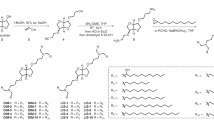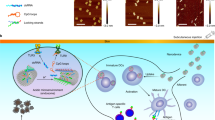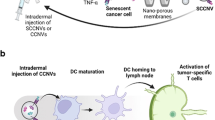Abstract
There is no clinically available cancer immunotherapy that exploits Langerhans cells (LCs), the epidermal precursors of dendritic cells (DCs) that are the natural agent of antigen delivery. We developed a DNA formulation with a polymer and obtained synthetic ‘pathogen-like’ nanoparticles that preferentially targeted LCs in epidermal cultures. These nanoparticles applied topically under a patch-elicited robust immune responses in human subjects. To demonstrate the mechanism of action of this novel vaccination strategy in live animals, we assembled a high-resolution two-photon laser scanning-microscope. Nanoparticles applied on the native skin poorly penetrated and poorly induced LC motility. The combination of nanoparticle administration and skin treatment was essential both for efficient loading the vaccine into the epidermis and for potent activation of the LCs to migrate into the lymph nodes. LCs in the epidermis picked up nanoparticles and accumulated them in the nuclear region demonstrating an effective nuclear DNA delivery in vivo. Tissue distribution studies revealed that the majority of the DNA was targeted to the lymph nodes. Preclinical toxicity of the LC-targeting DNA vaccine was limited to mild and transient local erythema caused by the skin treatment. This novel, clinically proven LC-targeting DNA vaccine platform technology broadens the options on DC-targeting vaccines to generate therapeutic immunity against cancer.
This is a preview of subscription content, access via your institution
Access options
Subscribe to this journal
Receive 12 print issues and online access
$259.00 per year
only $21.58 per issue
Buy this article
- Purchase on Springer Link
- Instant access to full article PDF
Prices may be subject to local taxes which are calculated during checkout






Similar content being viewed by others
References
Steinman RM . Decisions about dendritic cells: past, present, and future. Annu Rev Immunol 2012; 30: 1–22.
Stoitzner P, Green LK, Jung JY, Price KM, Tripp CH, Malissen B et al. Tumor immunotherapy by epicutaneous immunization requires langerhans cells. J Immunol 2008; 180: 1991–1998.
Banchereau J, Thompson-Snipes L, Zurawski S, Blanck J-P, Cao Y, Clayton S et al. The differential production of cytokines by human Langerhans cells and dermal CD14(+) DCs controls CTL priming. Blood 2012; 119: 5742–5749.
Romano E, Cotari JW, Barreira da Silva R, Betts BC, Chung DJ, Avogadri F et al. Human Langerhans cells use an IL-15R-α/IL-15/pSTAT5-dependent mechanism to break T-cell tolerance against the self-differentiation tumor antigen WT1. Blood 2012; 119: 5182–5190.
Romani N, Thurnher M, Idoyaga J, Steinman RM, Flacher V . Targeting of antigens to skin dendritic cells: possibilities to enhance vaccine efficacy. Immunol Cell Biol 2010; 88: 424–430.
Zaric M, Lyubomska O, Touzelet O, Poux C, Al-Zahrani S, Fay F et al. Skin dendritic cell targeting via microneedle arrays laden with antigen-encapsulated poly-d,l-lactide-co-glycolide nanoparticles induces efficient antitumor and antiviral immune responses. ACS Nano 2013; 7: 2042–2055.
Stoitzner P, Sparber F, Tripp CH . Langerhans cells as targets for immunotherapy against skin cancer. Immunol Cell Biol 2010; 88: 431–437.
Combadière B, Vogt A, Mahé B, Costagliola D, Hadam S, Bonduelle O et al. Preferential amplification of CD8 effector-T cells after transcutaneous application of an inactivated influenza vaccine: a randomized phase I trial. PLoS One 2010; 5: e10818.
Diebold SS, Kursa M, Wagner E, Cotten M, Zenke M . Mannose polyethylenimine conjugates for targeted DNA delivery into dendritic cells. J Biol Chem 1999; 274: 19087–19094.
Lisziewicz J, Tőke ER . Nanomedicine applications towards the cure of HIV. Nanomedicine 2013; 9: 28–38.
Lisziewicz J, Bakare N, Calarota S a, Bánhegyi D, Szlávik J, Ujhelyi E et al. Single DermaVir immunization: dose-dependent expansion of precursor/memory T cells against all HIV antigens in HIV-1 infected individuals. PLoS One 2012; 7: e35416.
Rodriguez B, Asmuth DM, Matining RM, Spritzler J, Jacobson JM, Mailliard RB et al. Safety, tolerability, and immunogenicity of repeated doses of DermaVir, a candidate therapeutic HIV vaccine, in HIV-infected patients receiving combination antiretroviral therapy: results of the ACTG 5176 trial. J Acquir Immune Defic Syndr 2013; 64: 351–359.
Lőrincz O, Tőke ER, Somogyi E, Horkay F, Chandran PL, Douglas JF et al. Structure and biological activity of pathogen-like synthetic nanomedicines. Nanomedicine 2012; 8: 497–506.
Bruewer M, Utech M, Ivanov AI, Hopkins AM, Parkos C a, Nusrat A . Interferon-gamma induces internalization of epithelial tight junction proteins via a macropinocytosis-like process. FASEB J 2005; 19: 923–933.
Sallusto F, Cella M, Danieli C, Lanzavecchia A . Dendritic cells use macropinocytosis and the mannose receptor to concentrate macromolecules in the major histocompatibility complex class II compartment: downregulation by cytokines and bacterial products. J Exp Med 1995; 182: 389–400.
Kissenpfennig A, Henri S, Dubois B, Laplace-Builhé C, Perrin P, Romani N et al. Dynamics and function of Langerhans cells in vivo: dermal dendritic cells colonize lymph node areas distinct from slower migrating Langerhans cells. Immunity 2005; 22: 643–654.
Lisziewicz J, Trocio J, Whitman L, Varga G, Xu J, Bakare N et al. DermaVir: a novel topical vaccine for HIV/AIDS. J Invest Dermatol 2005; 124: 160–169.
Duffy D, Perrin H, Abadie V, Benhabiles N, Boissonnas A, Liard C et al. Neutrophils transport antigen from the dermis to the bone marrow, initiating a source of memory CD8+ T cells. Immunity 2012; 37: 917–929.
Draize JH, Woodard G, Calvery HO . Methods for the study of irritation and toxicity of substances applied topically to the skin and mucous membranes. J Pharmacol Exp Ther 1944; 82: 377–390.
Racoosin EL, Swanson J A . M-CSF-induced macropinocytosis increases solute endocytosis but not receptor-mediated endocytosis in mouse macrophages. J Cell Sci 1992; 102: 867–880.
Van der Vlist M, Geijtenbeek TB . Langerin functions as an antiviral receptor on Langerhans cells. Immunol Cell Biol 2010; 88: 410–415.
Frugé RE, Krout C, Lu R, Matsushima H, Takashima A . Real-time visualization of macromolecule uptake by epidermal Langerhans cells in living animals. J Invest Dermatol 2012; 132: 609–614.
Kubo A, Nagao K, Yokouchi M, Sasaki H, Amagai M . External antigen uptake by Langerhans cells with reorganization of epidermal tight junction barriers. J Exp Medi 2009; 206: 2937–2946.
So P, Kim H, Kochevar I . Two-Photon deep tissue ex vivo imaging of mouse dermal and subcutaneous structures. Opt Express 1998; 3: 339–350.
Jeong G-J, Byun H-M, Kim JM, Yoon H, Choi H-G, Kim W-K et al. Biodistribution and tissue expression kinetics of plasmid DNA complexed with polyethylenimines of different molecular weight and structure. J Controlled Release 2007; 118: 118–125.
Sheets RL, Stein J, Manetz TS, Duffy C, Nason M, Andrews C et al. Biodistribution of DNA plasmid vaccines against HIV-1, Ebola, Severe Acute Respiratory Syndrome, or West Nile virus is similar, without integration, despite differing plasmid backbones or gene inserts. Toxicol Sci 2006; 91: 610–619.
Chen D, Payne LG . Targeting epidermal Langerhans cells by epidermal powder immunization. Cell Res 2002; 12: 97–104.
Xun S, Ch Simu, Jianfeng H, Zhirong Zh . Mannosylated biodegradable polyethyleneimine for targeted DNA delivery to dendritic cells. Int J Nanomed 2012; 7: 2929–2942.
Alshamsan A, Hamdy S, Haddadi A, Samuel J, El-Kadi AOS, Uludağ H et al. STAT3 knockdown in B16 melanoma by siRNA lipopolyplexes induces bystander immune response in vitro and in vivo. Transl Oncol 2011; 4: 178–188.
Pilling AM, Harman RM, Jones SA, McCormack NAM, Lavender D, Haworth R . The assessment of local tolerance, acute toxicity, and DNA biodistribution following particle-mediated delivery of a DNA vaccine to minipigs. Toxicol Pathol 30: 298–305.
García F, Climent N, Guardo AC, Gil C, León A, Autran B et al. A dendritic cell-based vaccine elicits T cell responses associated with control of HIV-1 replication. Sci Transl Med 2013; 5: 166ra2.
Strioga MM, Felzmann T, Powell DJ Jr, Ostapenko V, Dobrovolskiene NT, Matuskova M et al. Therapeutic dendritic cell-based cancer vaccines: the state of the art. Criti Rev Immunol 2013; 33: 489–547.
Gilboa E . DC-based cancer vaccines. J Clin Invest 2007; 117: 1195–1203.
Bauer J, Bahmer F a, Wörl J, Neuhuber W, Schuler G, Fartasch M . A strikingly constant ratio exists between Langerhans cells and other epidermal cells in human skin. A stereologic study using the optical disector method and the confocal laser scanning microscope. J Invest Dermatol 2001; 116: 313–318.
Goula D, Remy JS, Erbacher P, Wasowicz M, Levi G, Abdallah B et al. Size, diffusibility and transfection performance of linear PEI/DNA complexes in the mouse central nervous system. Gene Therapy 1998; 5: 712–717.
Chollet P, Favrot MC, Hurbin A, Coll J-L . Side-effects of a systemic injection of linear polyethylenimine-DNA complexes. J Gene Med 4: 84–91.
Kircheis R, Wightman L, Wagner E . Design and gene delivery activity of modified polyethylenimines. Adv Drug Deliv Rev 2001; 53: 341–358.
Wightman L, Kircheis R, Rössler V, Carotta S, Ruzicka R, Kursa M et al. Different behavior of branched and linear polyethylenimine for gene delivery in vitro and in vivo. J Gene Med 2001; 3: 362–372.
Palucka K, Banchereau J, Mellman I . Designing vaccines based on biology of human dendritic cell subsets. Immunity 2010; 33: 464–478.
Somogyi E, Xu J, Gudics A, Tóth J, Kovács AL, Lori F et al. A plasmid DNA immunogen expressing fifteen protein antigens and complex virus-like particles (VLP+) mimicking naturally occurring HIV. Vaccine 2011; 29: 744–753.
Toke ER, Lorincz O, Somogyi E, Lisziewicz J . Rational development of a stable liquid formulation for nanomedicine products. Int J Pharm 2010; 392: 261–267.
Stoitzner P, Romani N, McLellan AD, Tripp CH, Ebner S . Isolation of skin dendritic cells from mouse and man. Methods Mol Biol 2010; 595: 235–248.
Mayer EJ, Möbius J, Euteneuer A, Rühle WW, Szipocs R . Ultrabroadband chirped mirrors for femtosecond lasers. Opt Lett 1997; 22: 528–530.
Breunig HG, Studier H, König K . Multiphoton excitation characteristics of cellular fluorophores of human skin in vivo. Opt Express 2010; 18: 7857–7871.
Acknowledgements
We thank Drs Michael A Ussery and Hao Zhang (Division of AIDS, NIAID) for their support. The study was supported by NIH (N01-AI-70043) and Hungarian National Office for Research and Technology (FIBERSC2, contract no. TECH-09-A2-2009-0134 and DVCLIN01). FH acknowledges the support of the Intramural Research Program of the NICHD, NIH. CHT was in part supported by the COMET Center ONCOTYROL (Cell Therapy Unit), which is funded by the Austrian Federal Ministries for Transport, Innovation and Technology, and Economics, Family and Youth (via the Austrian Research Promotion Agency / FFG) and the Standortagentur Tirol.
Author information
Authors and Affiliations
Corresponding author
Ethics declarations
Competing interests
JL, ERT, ZC, OL, ES, LM, FL hold shares in Genetic Immunity Inc. The remaining authors declare no conflict of interest.
Additional information
Supplementary Information accompanies this paper on Gene Therapy website
Rights and permissions
About this article
Cite this article
Tőke, E., Lőrincz, O., Csiszovszki, Z. et al. Exploitation of Langerhans cells for in vivo DNA vaccine delivery into the lymph nodes. Gene Ther 21, 566–574 (2014). https://doi.org/10.1038/gt.2014.29
Received:
Revised:
Accepted:
Published:
Issue Date:
DOI: https://doi.org/10.1038/gt.2014.29



